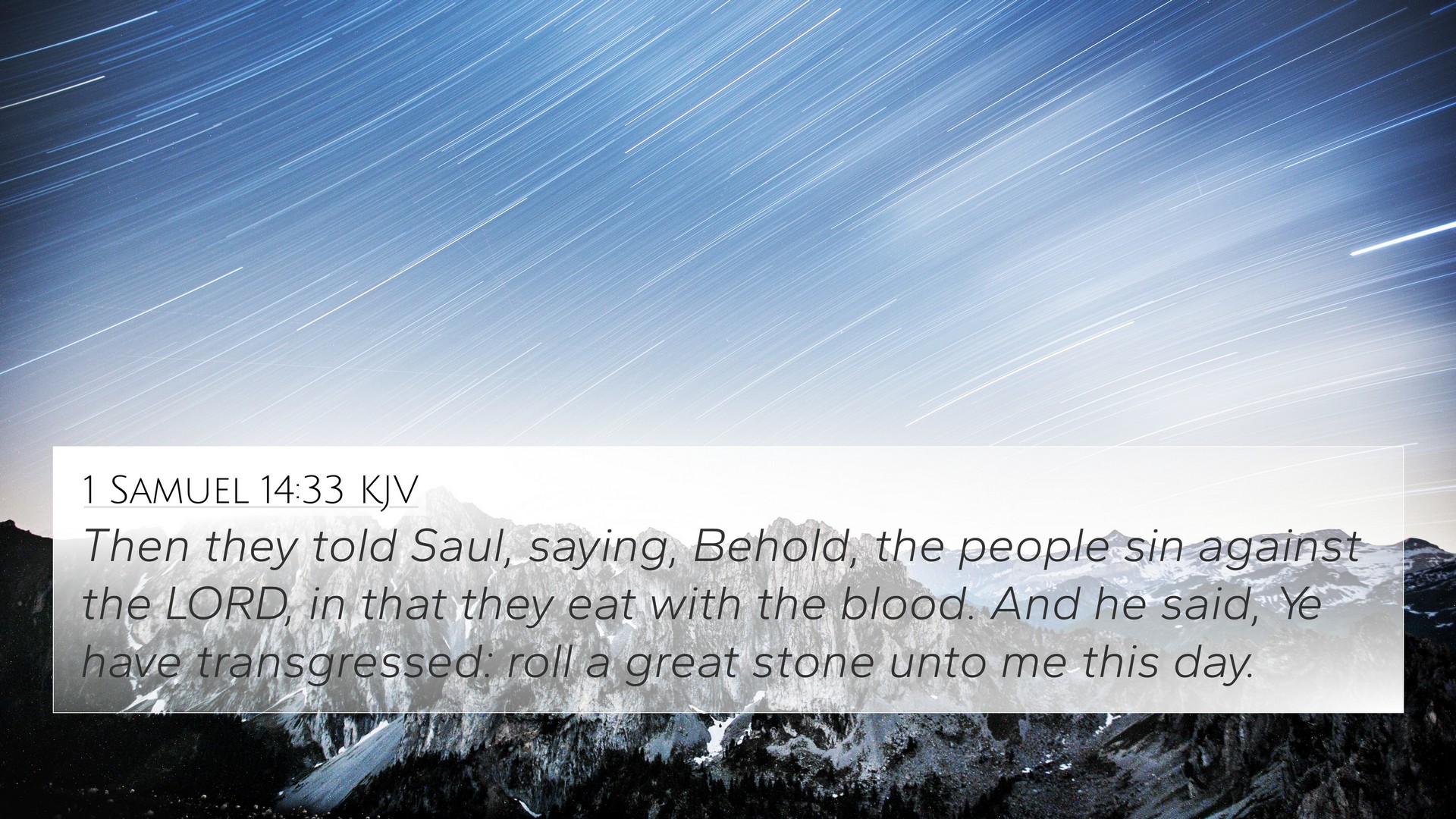Understanding 1 Samuel 14:33
Verse Text: "Then they told Saul, saying, 'Look, the people are sinning against the LORD by eating with the blood.' So he said, 'You have dealt treacherously; roll a large stone to me this day.'" (1 Samuel 14:33, NKJV)
Summary of the Verse Meaning
This verse presents a critical moment in the life of Saul as king of Israel, illustrating the tension between leadership and adherence to divine law. When Saul’s troops consumed meat with blood, they violated God’s commandments regarding dietary laws and the sanctity of blood. Saul’s response reflects a leader's duty to uphold God's law and address the transgressions of his people.
Insights from Public Domain Commentaries
Matthew Henry:
Matthew Henry emphasizes the seriousness of the sin of eating blood, which was explicitly forbidden in the Mosaic Law (Leviticus 17:10-14). He notes that Saul’s acknowledgment of the sin demonstrates a responsibility to lead in righteousness, not just in military endeavors. Henry points out that Saul's reaction to the sin was both a call to repentance and an act of authority to restore righteousness among the people.
Albert Barnes:
Albert Barnes focuses on the implications of the law regarding blood. He interprets the people's actions as a reflection of their ignorance and perhaps a lack of respect for God’s commands. Saul’s instruction to roll a stone signifies a chosen measure to rectify the situation by preparing the meat properly. Barnes highlights that this action serves as a reminder of the need for leadership to guide the people in spiritual and moral matters.
Adam Clarke:
In Clarke's commentary, he discusses the tradition that led to this sin. He illustrates that the troops may have been driven by hunger and the urgency of battle, which clouds moral judgment. Clarke interprets Saul’s command for the stone as a practical solution to ensure that meat is prepared in accordance with God's law, reinforcing the importance of obedience to divine directives even amidst challenging circumstances.
Thematic Bible Verse Connections
This verse can be connected to several themes found throughout scripture, highlighting the seriousness of dietary laws, leadership responsibilities, and the tension between human desires and divine commandments. The following verses can be utilized for comparative analysis:
- Leviticus 17:10-14: God's commandment regarding the prohibition of blood consumption.
- Deuteronomy 12:16: Further instructions on the treatment of blood in relation to animal sacrifices.
- 1 Samuel 10:8: Saul's previous instructions to offer sacrifices demonstrates a continued theme of obedience.
- Romans 14:21: The New Testament’s perspective on dietary choices and causing others to stumble in faith.
- Acts 15:20: The directives given by the Apostles concerning abstaining from blood, showing continuity in the moral laws.
- Ecclesiastes 8:11: The consequences of unaddressed sin among people and the impact of leadership.
- Hebrews 9:22: The significance of blood in redemptive history and its connection to sacrificial laws.
Cross-Referencing Biblical Texts
For individuals looking to delve deeper into the principles illustrated in 1 Samuel 14:33, utilizing various tools for Bible cross-referencing can enrich the understanding of scripture:
- Bible concordance: A systematic way to look up specific terms and concepts related to blood and dietary laws.
- Bible cross-reference guide: A resource to find specific cross-references that resonate with the themes in this verse.
- Cross-reference Bible study: Methods to explore the interconnections between the Law, the Prophets, and the New Testament teachings concerning obedience to God.
- How to use Bible cross-references: A guide for readers to follow themes and principles throughout the Bible.
- Bible reference resources: These can assist scholars in preparing thematic studies that highlight similar biblical principles.
Conclusion
1 Samuel 14:33 serves as a pivotal moment in understanding the balance between leadership and adherence to God’s commandments. By exploring the insights of historical commentaries and engaging with cross-referencing techniques, readers can gain a more comprehensive view of the implications and themes presented in this verse. This approach not only fosters a deeper understanding of the scripture itself but also encourages reflection on the responsible exercise of authority in a faith context.




